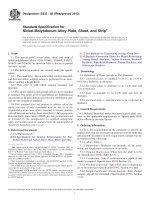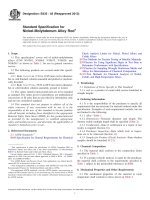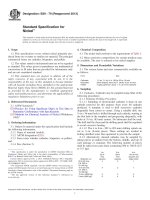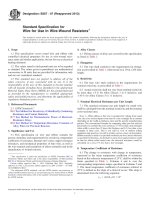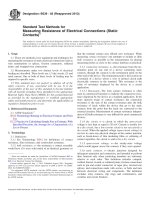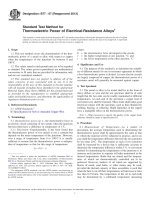Astm b 267 07 (2013)
Bạn đang xem bản rút gọn của tài liệu. Xem và tải ngay bản đầy đủ của tài liệu tại đây (92.69 KB, 5 trang )
Designation: B267 − 07 (Reapproved 2013)
Standard Specification for
Wire for Use In Wire-Wound Resistors1
This standard is issued under the fixed designation B267; the number immediately following the designation indicates the year of
original adoption or, in the case of revision, the year of last revision. A number in parentheses indicates the year of last reapproval. A
superscript epsilon (´) indicates an editorial change since the last revision or reapproval.
1. Scope
4. Alloy Classes
1.1 This specification covers round wire and ribbon with
controlled electrical properties for use in wire-wound resistance units and similar applications, but not for use as electrical
heating elements.
4.1 Fifteen classes of alloys are covered by this specification
as listed in Table 1.
1.2 The values stated in inch-pound units are to be regarded
as standard. The values given in parentheses are mathematical
conversions to SI units that are provided for information only
and are not considered standard.
1.3 This standard does not purport to address all of the
safety concerns, if any, associated with its use. It is the
responsibility of the user of this standard to become familiar
with all hazards including those identified in the appropriate
Material Safety Data Sheet (MSDS) for this product/material
as provided by the manufacturer, to establish appropriate
safety and health practices, and determine the applicability of
regulatory limitations prior to use.
5.1 The wire shall conform to the requirements for elongation as prescribed in Table 1, when tested on a 10-in. (254-mm)
length.
5. Elongation
6. Resistivity
6.1 The bare wire shall conform to the requirements for
nominal resistivity as prescribed in Table 1.
6.2 Actual resistivity shall not vary from nominal resistivity
by more than 65 % for Alloy Classes 1 to 4 inclusive, and
610 % for Alloy Classes 5 to 11 inclusive.
7. Nominal Electrical Resistance per Unit Length
2. Referenced Documents
7.1 The nominal resistance per unit length for round wire
shall be calculated from the nominal resistivity and the nominal
cross-sectional area.
2.1 ASTM Standards:2
B63 Test Method for Resistivity of Metallically Conducting
Resistance and Contact Materials
B77 Test Method for Thermoelectric Power of ElectricalResistance Alloys
B84 Test Method for Temperature-Resistance Constants of
Alloy Wires for Precision Resistors
NOTE 1—When ribbon or flat wire is produced by rolling from round
wire, the cross section departs from that of a true rectangle by an amount
depending on the width-to-thickness ratio and the specific manufacturing
practice. The conventional formula for computing ohms per foot and feet
per pound is to consider the cross section as 17 % less than a true rectangle
when width is more than 15 times the thickness and 6 % less than a true
rectangle in other cases. This is not valid in view of modern rolling
equipment and practices, but still is widely used as a basis of description.
Ribbon actually is made to a specified resistance per foot, and no tolerance
is specified for thickness. An alternative and a closer approximation would
be that for ribbon rolled round wire, the electrical resistance would be
calculated on a cross 6 % less than a true rectangle.
3. Significance and Use
3.1 This specification on wire and ribbon contains the
generic chemistry and requirements for resistivity, temperature
coefficient of resistance, thermal emf versus copper resistance
tolerances, and mechanical properties of bare wire, as well as
the wire enamels and insulations of alloys normally used in the
manufacture of wound resistors.
8. Temperature Coefficient of Resistance
8.1 The change in resistance with change in temperature,
expressed as the mean temperature coefficient of resistance
based on the reference temperature of 25°C, shall be within the
limits specified in Table 1, Columns 4 and 6, over the
corresponding temperature ranges specified in Columns 5 and
7. The mean temperature coefficient of resistance referred to
25°C is defined as the slope of a chord of an arc. This slope is
determined from the following equation:
1
This specification is under the jurisdiction of ASTM Committee B02 on
Nonferrous Metals and Alloys and is the direct responsibility of Subcommittee
B02.10 on Thermostat Metals and Electrical Resistance Heating Materials.
Current edition approved May 1, 2013. Published May 2013. Originally
approved in 1952. Last previous edition approved in 2007 as B267 – 07. DOI:
10.1520/B0267-07R13.
2
For referenced ASTM standards, visit the ASTM website, www.astm.org, or
contact ASTM Customer Service at For Annual Book of ASTM
Standards volume information, refer to the standard’s Document Summary page on
the ASTM website.
α
Copyright © ASTM International, 100 Barr Harbor Drive, PO Box C700, West Conshohocken, PA 19428-2959. United States
1
m
5 ~ ∆R/R 25∆T ! 3 106
B267 − 07 (2013)
TABLE 1 Classes of Alloys and Requirements
Alloy
Class A
1
1a
1b
1c
2a
2b
3a
3b
Alloy Composition,
approximate, %
Resistivity,
Ω·cmil/ft
(µΩ·m)
2
3
nickel base, nonmagnetic
nickel base, nonmagnetic
nickel base, nonmagnetic
iron base, magnetic
iron base, magnetic
80 nickel, 20 chromium
80 nickel, 20 chromium,
stabilized
4 60 nickel, 16 chromium,
balance iron
5a 55 copper, 45 nickel
5b 55 copper, 45 nickel
6 manganin type
7 77 copper, 23 nickel
8 70 nickel, 30 iron
9 90 copper, 10 nickel
10 94 copper, 6 nickel
11
98 copper, 2 nickel
800
800
800
800
800
650
675
Mean Temperature Coefficient of Resistance, αm ppm for Maximum Thermal emf
°C Over Temperature Range,∆ T
versus Copper, mV/°C B
∆T
αm
∆T
mV/°C
Temperature
Range, ∆ T C
5
6
7
8
9
4
Elongation in 10 in., min, %
0.002 to
Over
0.0009
0.001
0.002
in. D in
D
D
in. in Diameter
in. in
Diameter Diameter and Finer
10
11
12
(1.330)
(1.330)
(1.330)
(1.330)
(1.330)
(1.081)
(1.122)
0, ±20
0, ±10
0, ±5
0, ±20
0, ±10
+80, ±20
+60, ±20
+25
+25
+25
+25
+25
+25
+25
to −55
to −55
to −55
to −55
to −55
to −55
to −55
0, ±20
0, ±10
0, ±5
0, ±20
0, ±10
+80, ±20
+60, ±20
+25
+25
+25
+25
+25
+25
+25
to +105
to +105
to +105
to +105
to +105
to +105
to +105
+0.003
+0.003
+0.003
−0.004
−0.004
+0.006
+0.006
−65
−65
−65
−65
−65
−65
−65
to +250
to +150
to +150
to +200
to +150
to +250
to +250
10
10
10
10
10
15
15
5
5
5
5
5
5
5
3
3
3
3
3
3
3
675 (1.122)
+140, ±30
+25 to −55
+140, ±30
+25 to +105
+0.002
−65 to +200
15
5
3
0, ±20
0, ±40
0, ±15E
+180, ±30
+3600, ±400
+450, ±50
+700, ±200
+1400, ±300
+25 to −55
+25 to −55
0, ±20
0, ±40
0, ±15E
+180, ±30
+4300, ±400
+450, ±50
+700, ±200
+1400, ±300
+25 to +105
+25 to +105
−0.045
−0.045
−0.003
−0.037
−0.040
−0.026
−0.022
0.014
−65 to + 150
−65 to +150
+15 to +35
−65 to +150
−50 to +100
−65 to +150
−65 to +150
−65 to +150
15
15
15
15
15
15
15
15
5
5
5
5
5
5
5
5
3
3
3
3
3
3
3
3
300
300
290
180
125
90
60
30
(0.499)
(0.499)
(0.482)
(0.299)
(0.199)
(0.150)
(0.100)
(0.050)
E
+25
+25
+25
+25
+25
to −55
to −50
to −55
to −55
to −55
E
+25
+25
+25
+25
+25
to +105
to +104
to +105
to +105
to +105
A
Alloy Classes 1a to 8 inclusive are designed to provide controlled temperature coefficients. Values shown for other classes are for information only. All values are based
on a reference temperature of 25°C.
B
Alloy Classes 1a, 1b, 1c, 2a, 2b, 3a, 4, and 6 are designed to give a low emf versus copper. Values shown for other classes are for information only. Maximum indicates
the maximum deviation from zero and the plus or minus sign the polarity of the couple.
C
The maximum temperature values listed apply to the alloy wire only. Caution should be exercised pending knowledge of the maximum temperature of use for the coating
material involved.
D
If metric sizes are desired, 1 in. = 25.4 mm.
E
Alloy Class 6 (manganin type for resistors), has a temperature-resistance curve of parabolic shape with the maximum resistance normally located between 25 and 30°C.
Thus, Columns 5 and 7 cannot indicate 25°C as a limit but αm may be expressed as a maximum of + 15 ppm for 15°C to the temperature of maximum resistance and a
maximum of − 15 ppm from the temperature of maximum resistance to 35°C. All of the information included in this note is based on measurements made in accordance
with Test Method B84.
where:
αm = mean temperature coefficient of resistance, ppm/°C,
Table 1, Columns 4 and 6,
∆ R = change in resistance over temperature range indicated
in Table 1, Columns 5 and 7,
R25 = resistance at 25°C,
∆T = temperature range indicated in Table 1, Columns 5
and 7.
Form
Over 0.005 in. (0.127 mm) in diameter
0.002 to 0.005 in. (0.051 to 0.127 mm) in diameter, incl
Under 0.002 in (0.051 mm) in diameter
Ribbon
Permissible
Variation, ±%
5
8
10
5
10.2 For Alloy Classes 1 to 4 inclusive, the actual resistance
of any 1-ft length of wire in one spool or coil shall not vary by
more than 3 % from the actual resistance of any other 1 ft of
wire in the same spool or coil.
8.2 For Alloy Classes 1, 2, and 5, the temperature coefficient
as specified in Table 1 of any 10-ft (3-m) length shall not vary
more than 3 ppm/°C from that of any other 10-ft length on the
same spool or coil.
10.3 For Alloy Classes 5 to 11 inclusive, the actual resistance of any 1-ft length of wire in one spool or coil shall not
vary by more than 5 % from the actual resistance of any other
1 ft of wire in the same spool or coil.
9. Thermal EMF with Respect to Copper
11. Permissible Variations in Dimensions
9.1 The thermal electromotive force (emf) with respect to
copper shall fall within the limits shown in Table 1, in the
corresponding temperature ranges.
11.1 Permissible variations in dimensions of bare wire are
not specified, since these materials are used for resistance
purposes, in which the resistivity and the electrical resistance
per unit length, rather than the dimensions, are of prime
importance. The electrical resistance per unit length can be
determined more accurately than the dimensions of very small
wire.
10. Permissible Variations in Electrical Resistance
10.1 The actual resistance per unit length of any wire
furnished under these specifications shall not vary from the
nominal resistance by more than the following amounts:
2
B267 − 07 (2013)
TABLE 2 Dimensions of Enamel Coated Wire A
Nominal Bare Wire Size
A
Light Coated Wire
B&S Gage No.
Diameter, in.
Outside Diameter,
min, in.
28
29
30
31
32
33
34
35
36
37
38
39
40
0.0126
0.0113
0.010
0.0089
0.008
0.0071
0.0063
0.0056
0.005
0.0045
0.004
0.0035
0.0031
0.00275
0.0025
0.00225
0.002
0.00175
0.0015
0.0014
0.0013
0.0012
0.0011
0.001
0.0009
0.0008
0.0007
0.0006
0.0005
0.0130
0.0116
0.0103
0.0092
0.0083
0.0073
0.0064
0.0057
0.0051
0.0046
0.0041
0.0036
0.0032
0.0029
0.0026
0.00235
0.0021
...
...
...
...
...
...
...
...
...
...
...
...
Medium Coated Wire
Heavy Coated Wire
Outside Diameter,
max, in.
Outside Diameter,
min, in.
Outside Diameter,
max, in.
Outside Diameter,
min, in.
Outside Diameter,
max, in.
0.0134
0.0120
0.0107
0.0096
0.0086
0.0076
0.0067
0.0060
0.0054
0.0049
0.0043
0.0038
0.0034
0.0031
0.0028
0.0025
0.0022
0.0019
0.0016
0.0015
0.0014
0.0013
0.0012
0.0011
0.0010
0.0009
0.0008
0.0007
0.0006
0.0134
0.0120
0.0107
0.0096
0.0086
0.0076
0.0067
0.0060
0.0054
0.0049
0.0043
0.0038
0.0034
0.0031
0.0028
0.0025
0.0022
0.0019
0.0016
0.0015
0.0014
0.0013
0.0012
0.0011
0.0010
0.0009
0.0008
0.0007
0.0006
0.0139
0.0125
0.0112
0.0100
0.0090
0.0080
0.0071
0.0064
0.0057
0.0052
0.0046
0.0041
0.0037
0.0033
0.0030
0.0027
0.0024
0.0021
0.0018
0.0017
0.0016
0.0015
0.0014
0.0013
0.0012
0.0010
0.0009
0.0008
0.0007
0.0139
0.0125
0.0112
0.0100
0.0090
0.0080
0.0071
0.0064
0.0057
0.0052
0.0046
0.0041
0.0037
0.0033
0.0030
0.0027
0.0024
0.0021
0.0018
0.0017
0.0016
0.0015
0.0014
0.0013
0.0012
0.0010
0.0009
0.0008
0.0007
0.0144
0.0130
0.0116
0.0103
0.0093
0.0083
0.0074
0.0067
0.0060
0.0055
0.0049
0.0043
0.0039
0.0035
0.0032
0.0029
0.0026
0.0023
0.0020
0.0019
0.0018
0.0017
0.0016
0.0015
0.0014
0.0012
0.0010
0.0009
0.0008
To convert from inches to millimetres multiply by 25.4.
TABLE 3 Recommended Maximum Temperatures
Coating
12. Finish
12.1 The wire shall be as uniform and free from kinks, curls,
and surface defects such as seams, laminations, scale, and other
irregularities as the best commercial practice will permit.
Poly(vinyl formal)-phenolic
Poly(vinyl formal)-urethane
Polyurethane
Nylon
Epoxy
Terephthalate-polyester
Polyurethane-polyester
Modified silicones
Tetrafluorethylene
Polyester-imide
Polyimide
13. Enamel Coatings
13.1 Enamel coatings shall include any baked-on film of
insulating material, such as varnish enamel, polyurethane,
vinyl acetal, etc. and shall conform to the requirements
prescribed in 13.2 to 13.7.
13.2 The physical dimensions of the enamel film shall
conform to the requirements specified in Table 2.
Temperature, max,°C
105
105
105
105
105
130
155
155
180
180
220
13.6 The nominal temperatures specified in 13.5 do not
restrict the use of materials at other temperatures when
combined with insulation systems and proven by system test
procedures.
13.3 The continuity of dielectric strength of medium or
heavy enamel shall show a maximum of 10 breaks/100 ft. The
test circuit shall have a recording sensitivity of 300 000 Ω 6
20 % with 150 V across the coating. The tension on the wire
shall not exceed one half of its yield strength.
13.7 Enameled wire shall withstand the following solubility
test: Immerse a sample of the enameled wire in neutral mineral
transformer oil for 48 h at 100°C, after which the enamel shall
not be sufficiently softened so that it can be rubbed off with
cheese cloth. The rubbing action shall be sufficiently slow so
that the coating is not heated by friction. The test shall be made
2 to 10 min after removal of the wire from the oil, lightly
wiping off the excess oil.
13.4 The coating shall have excellent adherence to the wire
on which it is applied, allowing elongation until the wire
breaks without rupture of the coating or loosening of its bond.
The surface of the coating shall be smooth and uniform. The
enamel shall not be underbaked so that one turn adheres to the
next on a spool.
14. Insulated Coverings
13.5 The recommended maximum temperature of use of
wire coated with various materials shall be approximately as
listed in Table 3.
14.1 Insulated coverings on wire shall include any wrapped
textile covering such as cotton, silk, nylon, glass, etc. It shall
3
B267 − 07 (2013)
TABLE 5 Recommended Maximum Temperatures of Use for
Covered Wire
include both single and double coverings. The second covering
shall be wrapped in the opposite direction from the first.
Material
14.2 The insulating covering shall be wrapped firmly,
closely, evenly, and continuously around the wire. It shall be
free from voids or bare spots and have a minimum of back
twist. The covering shall be sufficiently closely wrapped so
that, when the wire is bent around a mandrel having a diameter
ten times the overall diameter of the covered wire, using only
enough tension to give an even compact layer, the wrappings
will not open enough to make the wire underneath visible to the
unaided eye.
Diameter of Wire, in. (mm) A
15.2 Temperature Coeffıcient of Resistance—The change in
resistance with change in temperature shall be measured in
accordance with Test Method B84.
15.3 Thermal EMF—The thermal emf with respect to copper shall be determined in accordance with Test Method B77.
TABLE 4 Nominal Outside Diameters of Insulated Coverings A
0.0253
0.0226
0.0201
0.0179
0.0159
0.0142
0.0126
0.0113
0.010
0.0089
0.008
0.0071
0.0063
0.0056
0.005
0.0045
0.004
0.0035
0.0031
0.00275
0.0025
0.00225
0.002
0.00175
0.0015
0.0014
0.0013
0.0012
0.0011
0.001
A
0.027
0.024
0.022
0.0197
0.0177
0.0160
0.0144
0.0131
0.0118
0.0107
0.0098
0.0089
0.0081
0.0074
0.0068
0.0063
0.0058
0.0053
0.0049
0.0043
0.0041
0.0038
0.0036
0.0033
0.003
0.003
0.0029
0.0028
0.0027
0.0026
0.0288
0.0261
0.0236
0.0214
0.0194
0.0177
0.0161
0.0148
0.0135
0.0124
0.0115
0.0106
0.0098
0.0091
0.0085
0.008
0.0075
0.007
0.0066
0.0058
0.0055
0.0053
0.005
0.0048
0.0045
0.0044
0.0043
0.0042
0.0041
0.0040
0.0300
0.0273
0.0248
0.0224
0.0204
0.0187
0.0171
0.0158
0.0145
0.0134
0.0125
0.0116
0.0108
0.0101
0.0090
0.0085
0.0080
0.0075
0.0071
...
...
...
...
...
...
...
...
...
...
...
Weight per Spool,
min, lb (kg) B
Capacity of Spool,
lb (kg) B
0.004
0.01
0.015
0.025
0.035
0.04
0.05
0.06
0.07
0.08
0.09
0.10
0.15
0.25
0.50
2.50
1
1
1
1
1
1
1
1
1
1
1
1
1
1
2
5
0.0005
0.0006
0.0007
0.0008
0.0009
0.001
0.0011
0.0012
0.0013
0.0014
0.0015
0.00175 to 0.00225
0.0025 to 0.0031
0.0035 to 0.0056
0.0063 to 0.010
0.0113 to 0.0226
15.1 Resistivity—Test Method B63.
Nominal
Bare Wire
Diameter,
in. (mm)
105
105
105
220
(polyimide)
TABLE 6 Quantities of Wire and Capacities of Spools
15. Test Methods
Nominal
Diameter
Over Single Cotton
or Single
Glass,
in. (mm)
90
90
90
400 A
A
The purchaser should investigate the stability of the wire alloy under the
temperature condition indicated.
14.4 The recommended maximum temperatures of use of
wire covered with various materials are shown in Table 5.
Nominal
Diameter
Over
Double
Silk or
Double
Nylon
in. (mm)
Varnish Coated
Silk
Nylon
Cotton
Glass
14.3 The nominal outside diameters (over insulation) shall
be as shown in Table 4.
Nominal
Diameter
Over Single Silk or
Single Nylon,
in. (mm)
Temperature of Use, max, °C
Uncoated
Nominal
Diameter
Over
Double
Cotton or
Double
Glass,
in. (mm)
A
B
To convert from inches to millimetres multiply by 25.4.
To convert from pounds to kilograms multiply by 0.453.
TABLE 7 Types and Sizes of Spools
Capacity of
Spool, lb (kg) A
0.0338
0.0311
0.0286
0.0264
0.0244
0.0227
0.0211
0.0198
0.0185
0.0174
0.0165
0.0156
0.0148
0.0141
0.0130
0.0125
0.0120
0.0115
0.0111
...
...
...
...
...
...
...
...
...
...
...
1
2
5
A
B
Spool Dimensions, in. (mm) B
Diameter of
Flange
Traverse
Diameter of Hole
Diameter of
Barrel
2 1⁄2
3
4 to 41⁄2
3
3
3
0.635
0.635
0.635
11⁄4 to 13⁄4
11⁄2 to 2
11⁄2 to 3
To convert from pounds to kilograms multiply by 0.453.
To convert from inches to millimetres multiply by 25.4.
16. Packaging
16.1 Bare, enameled, and insulated wire shall be supplied
on spools and in quantities in accordance with Table 6. Ten
percent of any order may be 75 % of the spool weight. Wire
larger in diameter than sizes listed in Table 6 may be supplied
on spools (Table 7) or in coils depending on agreement
between the manufacturer and the purchaser. All alloys covered
by these specifications are not available in all of the indicated
sizes.
16.2 There shall be no splices or welds in coils or spools of
wire.
16.3 All wire finer than 0.0035 in. (0.0889 mm) in diameter
shall be shipped with each spool in an individual carton.
To convert from inches to millimetres multiply by 25.4.
4
B267 − 07 (2013)
17. Marking
Alloy Class
1
3
4
5
6
17.1 Coils or spools shall be tagged or marked to show the
size, alloy class, resistance per foot, coating or insulation if
any, and date.
17.2 The mean temperature coefficient of resistance from 25
to 150°C and 25 to −65°C shall be marked on the labels for
Alloy Classes 1 and 2.
Color
purple
yellow
red
pink
ivory
18. Keywords
18.1 precision resistors; resistivity; resistor alloys; resistors;
wire wound
17.3 The alloy classes shall be identified with a tag or label
of a specified color as follows:
ASTM International takes no position respecting the validity of any patent rights asserted in connection with any item mentioned
in this standard. Users of this standard are expressly advised that determination of the validity of any such patent rights, and the risk
of infringement of such rights, are entirely their own responsibility.
This standard is subject to revision at any time by the responsible technical committee and must be reviewed every five years and
if not revised, either reapproved or withdrawn. Your comments are invited either for revision of this standard or for additional standards
and should be addressed to ASTM International Headquarters. Your comments will receive careful consideration at a meeting of the
responsible technical committee, which you may attend. If you feel that your comments have not received a fair hearing you should
make your views known to the ASTM Committee on Standards, at the address shown below.
This standard is copyrighted by ASTM International, 100 Barr Harbor Drive, PO Box C700, West Conshohocken, PA 19428-2959,
United States. Individual reprints (single or multiple copies) of this standard may be obtained by contacting ASTM at the above
address or at 610-832-9585 (phone), 610-832-9555 (fax), or (e-mail); or through the ASTM website
(www.astm.org). Permission rights to photocopy the standard may also be secured from the ASTM website (www.astm.org/
COPYRIGHT/).
5

